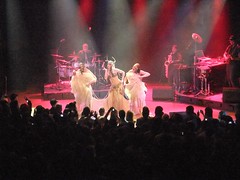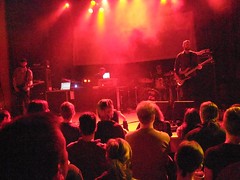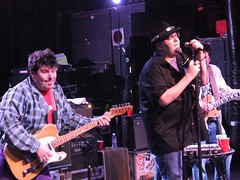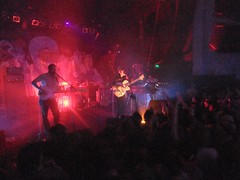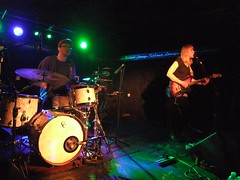I got the chance to sit down with Senon Williams and Ethan Holtzman from
Dengue Fever before their show at the Bluebird Theater on 24 January 2011. Both the guys were easy to talk to as we discussed their Cambodian experiences, their musical roots, and more.
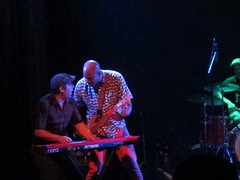 Jester: As I understand it, both of you traveled to Cambodia before starting the band. I've heard Senon talking about discovering music in the Cambodian market and I know that Ethan’s trip inspired starting the band. Were those independent trips?
Jester: As I understand it, both of you traveled to Cambodia before starting the band. I've heard Senon talking about discovering music in the Cambodian market and I know that Ethan’s trip inspired starting the band. Were those independent trips?Senon Williams: Yeah
Ethan Holtzman: Completely
SW: I traveled there. I wasn’t even planning on going to Cambodia. I was in Thailand, chilling on a beach with my girlfriend and people were offering us massages and manicures and fruit. We were thinking, “We can go to Mexico for this. We didn’t travel halfway around the world to chill on the beach.” We tried changing our visas to go to Viet Nam, but, this was ’95, we couldn’t change our visas. We still had to go home in two weeks. With a little research, we found out that in Cambodia, you can get your visa when you land. So, on a whim, we went to Cambodia and had the best time of our trip.
EH: I just got a one way ticket to Bangkok, Thailand. I was traveling with my ex-girlfriend for six months in Southeast Asia. I was figuring it out as it went along. Cambodia was one of the countries where we thought we should go, but we thought we should read up beforehand, because it was kind of sketchy still. Now, it’s changed a lot. But when Senon was there and when I was there… if there was an election there, it was still very unstable. A couple of French tourists took the train and were killed.
SW: When I was there, we were under strict warnings not to take any public long distance travel.
EH: Now, we go there as a band. We’ve been there three times. The last time was a month and a half ago and we got to play in almost all the different provinces. All the major cities.
SW: But you still don’t go off the path. Not because you’re afraid of people, but because there are a lot of unmarked mine fields that they’re still clearing. There have been minefields laid in different wars and generally, they’d be documented by the army because they don’t want to go back and blow themselves up. But in Cambodia, they would just set up minefields, camp for the night and move on without keeping any records, So, there’s no idea where all the mines are.
EH: They’d lay all the mines around the camp so if anyone tried to attack at night, they’d be safe. Then, they’d leave them. It’s just random.
SW: Probably themselves, they wouldn’t go hiking back in there, the next week.
EH: But there are organizations combing acre by acre. One’s called
HALO. It’s supposed to be a really good organization. They’re clearing all the landmines. It takes time. But no one’s been killed doing it and they’re all Cambodians working.
SW: They came out to one of our shows at Siem Reap and met us. We had planned to go out to one of their sites, where they’re working on. But our schedule was so rigorous that we didn’t have time to go check it out.
When you guys were just back there, how did Cambodia compare to your first visit with the band?SW: From 2005, it’s changed just as much as it changed from 1995 to 2005. The rapid growth is pretty amazing. When me and Ethan were there in the ‘90s, there were no took-tooks (small motorized cabs) and the roads were still coated in a thick layer of dirt. We came back in 2005 and the roads were all cleaned up and it was nice. But it was still really gritty, with trash in the street. This last time going, I didn’t see trash piles everywhere. There were took-tooks, which didn’t used to be there. There was a big mall in the middle of town.
EH: There was major development. We went in 2010 and 2011. We were fortunate enough to go twice. It’s taken on a new purpose. We play music and we also raise money for good charities that we’re collaborating with.
Cambodian Living Arts is the main one. They’re developing there. We played a show on Koh Pich...
SW: Koh Pich Island. There was this little, tiny patch of dirt that they called an island. They had a bridge to it. And they’ve since made it ten times as big. They’ve developed something equivalent to a convention center on it as well as a bunch of little shops. And a huge European style park, which is strange for Phnom Penh.
But I think one of the things that’s changed since 2005 is that there was no real scene mixing the Khmer with the Westerners. I really felt that the last time we went there…There’s this place called the
Meta House and a bunch of different bars that were bridging these cultures. This place called the Bopanna Center which is a film and audio archive. They have Westerners and Cambodians working together. A friend of mine is over there now, Conrad Keely from ...And You Will Know Us by the Trail of Dead. He’s half Thai. He fell in love with Cambodia. Talking to him, because he’s been there for months, the scene he’s found in Phnom Penh is so mixed with Cambodians and Westerners playing in bands together, mixing all different types of sounds. There’s something happening there.
That must be cool, after seeing you guys in Sleepwalking Through the Mekong, where there was so much culture shock in both directions.SW: In this last trip, our friend organized the most amazing tour for us. We were doing really good work, we raised tons of money for a few different organizations. And we were reaching the people we wanted to reach. It was really a good feeling; it was great. We were hanging out with such good people when we were there.
As foreigners playing Cambodian influenced music, it can raise the question of cultural appropriation. But hearing you guys talk about Cambodia makes that a non-issue. You clearly have a strong connection and deep respect for the culture.SW: I don't try to appropriate anything Cambodian in me. I just play music and we have Nimol as our singer. There's an honesty with all of us. We're just who we are. We're not trying to take on a persona.
EH: What happened is that we kind of discovered how important this music was for that country and the history. These people died because of their music. We thought, "This music is great. It's totally obscure. Let's play a show and put this band together." Then all of the sudden, it started to have real meaning for Cambodians all around. Cambodian all around the world are finding out that this is the music that came from their past.
And it's being taken seriouslyEH: And it's cool because on this last trip, we were able to go to Battambang, which is a city we never toured in. This is where all the best musicians and singers were from. We did a workshop with these...they're not kids, they're probably like 18-20...they're musicians...
SW: The one guy was in his 40s...
EH: It's Phare. It's like a circus training, musician, arts kind of campus in Battembang. That's kind of where all this music started from. To go back there and play a show and jam with these kids...they're really, really good
SW: These kids are insanely good. We've collaborated with so many musicians and they're all amazing in their own right. But these kids that we met, it was like a renaissance with them. They'd be able to play along with anything that we played. And anything that they played, we'd be able to play along. We had this connection, musically. We can make do with anybody we jam with, but these guys...
EH: It was way different than playing with other Cambodians we've met. They're all great, but they're classically trained or they're in an orchestra. These were musicians that were on the same level, play by ear. That's kind of the root of what started the movement of Cambodian rock. It was really good for us to come across musicians that we could collaborate with. We got to play a huge show in the streets with them in Battembang. And they played a song with us. They played the traditional instruments, like the roneat ek, which is kind of like a xylophone.
SW: It's kind of like those kids have it. The older guy, I don't think he was the teacher, he was just in the band. It was this generation bridge. Going back to what we were talking about a minute ago, Cambodians have come up to me and said, "It's great what you're doing. I didn't listen to all of this stuff my parents listened to." Then they find on their own that they love Dengue Fever and they tell their parents about it. And their parents love Dengue Fever. None of this stuff was planned, but it's cool that we can bridge the gap between generations.
That is cool. If I can change the subject, can you each tell me what your musical roots are?SW: When I was a teenager, I was a little punk rocker in L.A., going to the Cathay de Grande and the Anti Club and Scream downtown. I was a punk rocker, but Hendrix was one of my idols growing up. I listened to a lot of jazz. I listened to a lot of Peter Tosh and Bob Marley as well. From an early age, I was into Funkadelic, pretty heavy duty. And Sly and the Family Stone. So, I'm from punk rock and '70s rock.
EH: I didn't realize how important some of the music I listened to as a little kid was, like when I was in 6th grade. Devo's
Freedom of Choice,
Talking Heads '77, Blondie's
Parallel Lines - my mom had that one.
SW: I had that one on a mix tape. A few Blondie songs
EH: Clash,
Combat RockSW: Clash, of course. That was heavy duty. Floyd, of course...
You know, on Cannibal Courtship, I heard a lot of that '70s, Two Tone era ska. After that I could hear it in the older stuff, too.SW: Wow. You might be the first, Jester. It's probably the horns
EH: Dave Ralicke, our horn player is not with us tonight. He's in L.A. He definitely has a deep reggae, ska kind of thing. He plays trombone.
SW: I ran sound for Jump With Joey, back in the day.
I hear it with moody songs that have a meandering bass line and the horn punches. It reminds me of Ghost Town by the Specials or some of those other old classics. You guys helped me discover that connection between that second wave ska sound and '60s garage or surf rock. That moody, reverby sound...SW: I remember during my punk rock days, I was so anti reverb. Now, I embrace it. More reverb!
EH: I used to play guitar in bands and I would just crank the treble. "That's the way I like it."
How much of what you guys do is improvisational?SW: We improv a ton when we write the songs. We all come in with ideas. Zac comes in with a lot of the main ideas and lyric ideas. But we also bring stories to Nimol. She says, "I don't know what to write about." So, we say, "This is what you write about." So, she'll take her turn. But we do a lot of improvising at rehearsals. We have a timeline of our last album on two track recordings and you can see how songs develop over time from the early stages. We do a lot of improvising in the studio, then we get the songs tight. Then, back live, we open them up again because we like to have fun. So, we keep these open sections. It may be Ethan raising his hand or Paul doing some drum fill that will cue us back into the main part of the song. Live, about half of our songs have these open sections for us to, if we're in the mood, take it someplace else.
EH: We can extend it. It's one of those things. Tonight's the first show of our tour, but by show ten, we all get more comfortable. Even though you have your part, you're embellishing.
SW: Sometimes, I stop playing to let everybody know, "I'm gonna throw a little curve here." I like to change things up, so people won't get upset when I change it up. So, people get used to the idea.
But that's also like a dub thing in reggae. People drop out, so you can appreciate all the other parts in their own space. Then, when you come back in, it opens things up.SW: I really missed you, man. Where were you
(laughs).
EH: I know what you're talking about.
My old reggae band had a motto, "dedication to the groove." It doesn't matter what your part is, your job is to make the song sound right.SW: Yeah.
Listening to you guys, like on Durian Dowry, the way the song goes through sections and everybody's got their part that fits just so. You can tell you it comes from listening to each other. I love that song.SW: There's so much going on. The only place that not so busy is the vocals. Nimol sings this beautiful sliding melody over the whole thing.
EH: That's something that we learned. On our first record, we were playing a bit more on top of ourselves. Then, over time, we learned to create space. When I hear that first record...
SW: I know what you mean. When we perform those songs live, it's a lot different than the album. I don't listen to the record, but when I do hear it, I say, "That's how we used to do that song?"
Lost in Laos is a perfect example. On the record, I played way trickier than I play it now. It used to be a full bass solo for three and a half minutes, so I toned that song down. But I didn't realize it until I heard it again.
EH: There was a cover that we had never heard before.
SW: That's half of our covers! Which one?
EH:
Lost in Laos. I finally heard a recorded version
SW: I've still never heard the original. That's not the only song. There's other ones where Nimol would start singing and we've never heard the original version. But we just followed along.
EH:
Hold My Hips.
SW: Yeah,
Hold My Hips!
EH: That's a song that we play every show, because it has her a capella and it's got a dance groove.
SW: But Nimol explained the song to us before we ever had a recording. Do this thing
(sings).
EH: I've still never heard
Hold My Hips.
SW: I've heard the original version and they do
(sings) and it's just like she sang us the parts.
EH: Nimol will sing us a song and we'll figure out the head and the parts.
SW: One time, we had to rewrite the head. She kept telling us that we were wrong, but we said, no, you're wrong!
Without having heard it?SW - Exactly
(laughs)Tell me about your tour mates, Secret Chiefs 3.EH: Trey and Danny were in Mr. Bungle. Danny's the drummer. His grandfather was Jascha Heifetz, the violinist.
Wow!SW: And the way that guy was to violin, homey is to drums.
EH: One of the best drummers ever. He's got such a dynamic style. He can play so light
SW: Effortless. So, if you see Paul, our drummer, shaking nervously, it's because Danny's in the crowd.
I'll wrap up with a favorite question: who would your dream tour be with.SW: The first thing that comes to mind is someone that we actually did play with, because it was so fabulous. Seun Kuti was so inspiring to me playing live.
EH: That's Fela Kuti's kid. He inherited Egypt 80 (his father's band). He got the band. Femi (another son) didn't get the band.
SW: Is there anybody you can think of?
EH: You have to know them before you can tell if they'd be good. We toured with Chicha Libre, they're nice guys, really good music...
SW: They'd have to be fun people. This is kind of a dream situation now, playing with Secret Chiefs 3. Trey, the leader of this band, he's a genius. And he put out our first album. We had a nice couple of weeks together making the record.
I really appreciate your time. Thanks
 Ritmo Machine is a victory for globalization and we're all winners. Latin Bitman and Eric Bobo each bring a fairly different perspective to the group, which offers a richer sound than either have on their own. Chilean DJ Latin Bitmap ponies up his great ear for mixing backing tracks that are steeped in both electronic and Latin influences. Bobo has a classic hip hop sensibility rooted in his work with Cyprus Hill and the Beastie Boys. Some of their common ground may well come from the influence of Bobo's father, afro-Cuban percussionist Willie Bobo. But it's clear that each one hears a space for their own voice in the collaboration.
Ritmo Machine is a victory for globalization and we're all winners. Latin Bitman and Eric Bobo each bring a fairly different perspective to the group, which offers a richer sound than either have on their own. Chilean DJ Latin Bitmap ponies up his great ear for mixing backing tracks that are steeped in both electronic and Latin influences. Bobo has a classic hip hop sensibility rooted in his work with Cyprus Hill and the Beastie Boys. Some of their common ground may well come from the influence of Bobo's father, afro-Cuban percussionist Willie Bobo. But it's clear that each one hears a space for their own voice in the collaboration.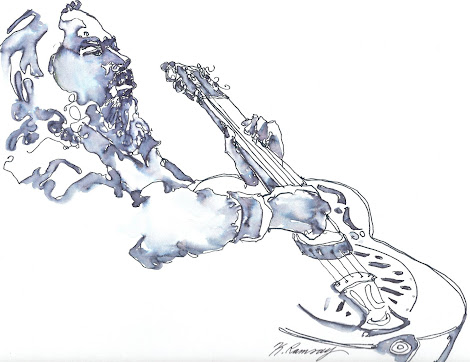


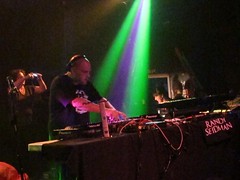
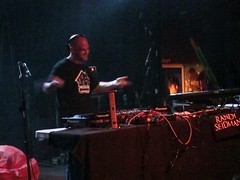



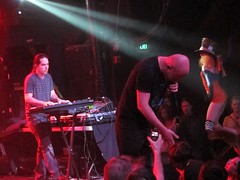
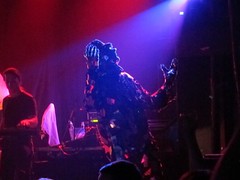



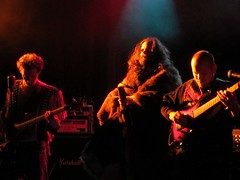
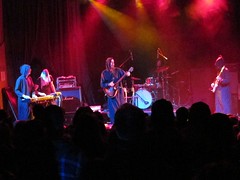
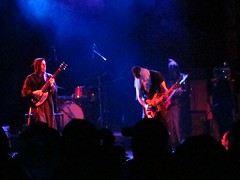














 Some bands embrace a retro sound as homage or to prove a certain kind of affiliation. Others are trying to capture a time or feeling that resonates with their psyche. Gary Brown's
Some bands embrace a retro sound as homage or to prove a certain kind of affiliation. Others are trying to capture a time or feeling that resonates with their psyche. Gary Brown's 
 Pete Townshend's
Pete Townshend's  Brooklyn trio
Brooklyn trio  Last month, Ryko released
Last month, Ryko released 